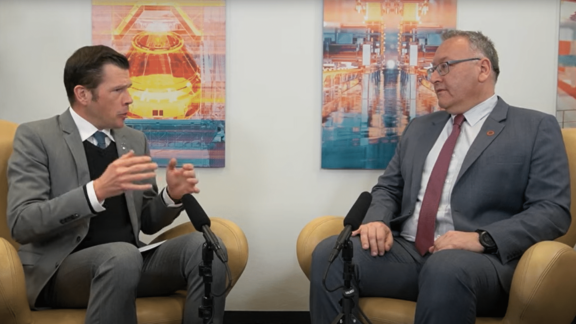This post is also available in: 简体中文 (Chinese (Simplified))
Dr. Alexander Fleischanderl joined Primetals Technologies in 1997 and led the development of the MEROS sinter off-gas cleaning system and many other technologies. He currently holds the position of Technology Officer Upstream and is Vice President of Iron- and Steelmaking. A keen innovator, Dr. Fleischanderl has registered some 100 patents to date and is always driven to explore what’s next. We asked him for his personal view on what if …

… you had to pick your favorite green-production technology? What’s the most promising one?
Dr. Alexander Fleischanderl: Let me answer this question by focusing on a future technology rather than one that we have already brought to market. For one and a half years now, I have been closely following developments in the area of direct electrolysis of steel. There is a U.S.-based start-up that has developed and operated a pilot plant for a couple of years and is currently taking the next step toward industrial production. Electrolysis replaces the traditional steel-production route with one simple process. It uses iron ore as input material, and the reducing agent is electricity. What’s more, electrolysis does not generate any carbon emissions; only oxygen is released into the atmosphere. It is simple and green—but it is still in the early stages. One challenge is the availability of cheap renewable energy: electrolysis can only be as environmentally friendly as its source of electrical energy. The second hurdle is the material the anode is made of—it has to be inert, chemically non-reactive. The third challenge is to get the metallurgy right and to achieve a proper distribution of trace elements between metal and slag. I am confident that these hurdles will be overcome within the next 5 years.
… hydrogen production suddenly became much cheaper? how Would this impact steel production?
Fleischanderl: I am sure that the “hydrogen revolution” will happen. Governments and the private sector are making enormous investments. There are extensive plans for future infrastructure projects—hydrogen pipelines, for example. Most of the problems related to the production and transport of hydrogen have already been solved. Even today, large amounts of hydrogen are already consumed by the oil and gas and chemical industries. But 95 percent of this hydrogen is “gray”—meaning that it was produced using hydro-carbon based energy sources. The future of hydrogen production has to be green. Wind and solar still have great potential, especially in certain parts of the world. Actually, I am in contact with an Australian initiative that intends to build large wind and solar farms in a desert close to them. They plan to use the resulting energy for the production of green hydrogen. Now, if you know that the same region is also home to iron ore mines … it’s very promising. At Primetals Technologies, we have initiated a lighthouse R&D project called HYFOR, a hydrogen-based fine-ore direct-reduction solution, which could be the perfect fit for the Australians. We’ll be commissioning the first pilot plant next year.
I am sure that the hydrogen revolution will happen. Hydrogen is no longer confined to the lab, with governments and the private sector making huge investments.”
… you imagined the world in 30 years’ time? How would it compare to the world of today?
Fleischanderl: If you compare the world of today to that of the 1980s, that gives you an idea of just how much can change over 30 years. I expect this progress to continue or even accelerate. In 2050, world steel production will be 40 to 50 percent higher, and new steel grades with incredible material properties will be available. Steel will also be produced with new methods, which will be significantly greener than those we are currently using. Many governments and leaders within the steel industry have set out goals that, by 2050, suggest an 80 to 95 percent reduction in carbon emissions. A reduction of this size has huge implications and will change the face of steel production forever. Aside from steel, 2050 will be different in many other ways, for instance, in terms of the energy sources we’ll be using. There are many questions that will have to be answered before then. New and improved ways to generate, store, transfer, and distribute renewable energy will have to be established. As hydrogen becomes cheaper and more available, car makers will start selling fuel-cell vehicles, which are far more appropriate for long-distance driving and heavy traffic than today’s electric cars and trucks.
… steel producers were to certify their end products for “greenness”—their CO2 and energy footprint?
Fleischanderl: Digitalization is still—and will continue to be—a key topic for steel producers. Thanks to cheap smart sensors and tools like Primetals Technologies’ Through-Process Optimization, the steel plants of today can generate and record vast amounts of data for every single coil they produce. This information does not have to be limited to process-relevant aspects but can extend to energy use and emission data. It is already common practice for plant operators to monitor and track emissions when and where they occur—with comprehensive online control systems. The same is true for energy use. Based on all of this information, it is actually quite easy to establish exactly how much energy was required to produce a given coil, and what the coil’s carbon footprint looks like. It is only a small additional step to introduce “green labeling” for each coil. I think that it is important—not only for Primetals Technologies but also for leading steel producers—to get this global trend started and embrace green labeling for all steel products as an industry standard. End customers will take such green labeling into consideration in their purchasing policy, and governments will be able to better institute appropriate carbon taxes.
It would be of great benefit to the steel industry as a whole if everyone had the same chances.”
… you could, by snapping your fingers, overcome one of the steel industry’s major challenges?
Fleischanderl: I think I would snap my fingers for more equality in the global steel industry. Steel producers in different countries are facing very different conditions—for instance, in terms of environmental regulations and energy prices. As a result, not every producer has the same opportunities. Energy costs are the crucial factor in this equation rather than labor, which only accounts for a few percent of overall production expenditures, and raw materials, which are traded on the global market. It would be of great benefit to the steel industry as a whole and the environment if everyone had the same chances.
… you were asked to choose only three measures to protect the environment on a global level?
Fleischanderl: The first measure I’d take is to accelerate the global efforts to achieve an order-of-magnitute increase in renewable energy production. This needs to happen over the next two decades. In 2018, wind and solar generated 65 times the power they did in 2000. Prices for renewable energy have fallen accordingly and are projected to reach the 30-dollars-per-MWh mark soon. As green energy becomes cheaper, hydrogen production will take off and lead to the decarbonization of the steel industry and other areas such as mobility and the chemical industry.
My second measure would be the mandatory implementation of meaningful energy-efficiency and recycling projects for heavy industry. Governmental institutions might have to support this initiative financially to make it economically viable. In the context of the steel industry, I’m talking about wasteheat recovery from the sinter cooler, electric arc furnace, and basic oxygen furnace, as well as from the liquid slag. Another technological area I see great potential in is that of bio-technologies. To give you an example: Primetals Technologies is a shareholder in the U.S. based company LanzaTech, which ferments the carbon-rich waste gases into ethanol using microorganisms. The process is similar to brewing beer, but under the harshest conditions. The resulting alcohol can be easily converted into gasoline, kerosene, or plastic. We are a proud partner in ArcelorMittal’s “Steelanol” project in Gent, Belgium, which will producing some 80 million liters of bio-ethanol per year from 2021 onward.
Third, I would want to ensure globally valid environmental standards and economic conditions. Moving steel-production sites from one country to the next to escape “expensive” environmental regulations does not help anyone in fighting climate change. All steel products should be labeled according to their carbon footprint, and carbon-intensive products should be taxed higher than low-carbon ones, worldwide. Unfortunately, you asked me to chose only three measures— there are so many more I can think of.


